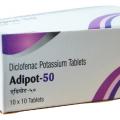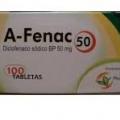Home / Categories / DICLOCOR GEL 30GM

DICLOCOR GEL 30GM
(10X20)
DICLOFENAC-50MG
NSAIDS-ANTIPYRETIC/ANALGESICS
COREL PHARMACEUTICALS PVT.LTD
Product Details
Quetiapine Fumarate
A to Z Drug Facts
| Quetiapine Fumarate |
| (cue-TIE-ah-peen) |
| Seroquel |
| Class: Antipsychotic |
 Action Has antipsychotic effects, apparently due to dopamine and serotonin receptor blockade in the CNS.
Action Has antipsychotic effects, apparently due to dopamine and serotonin receptor blockade in the CNS.
 Indications Management of manifestations of psychotic disorders.
Indications Management of manifestations of psychotic disorders.
 Contraindications Standard considerations.
Contraindications Standard considerations.
ADULTS: PO 25 mg bid initially; may increase by 25 to 50 mg bid to tid every 2 to 3 days to target range of 300 to 400 mg/day. Therapeutic dose range is 150 to 750 mg/day.
Inhibitors of CYP3A (eg, ketoconazole, itraconazole, fluconazole, erythromycin): May increase the effects of quetiapine; use with caution. Hepatic enzyme inducers (eg, carbamazepine, barbiturates, phenytoin, rifampin, glucocorticoids): May decrease the effects of quetiapine; increased doses of quetiapine may be necessary to maintain control of psychotic symptoms. Thioridazine: May decrease the effect of quetiapine. Lorazepam: Quetiapine increases the effects of lorazepam. Dopamine agonists (eg, ropinirole, pramipexole), levodopa: Quetiapine may antagonize therapeutic effects of dopamine agonists and levodopa.
 Lab Test Interferences None well documented.
Lab Test Interferences None well documented.
CV: Postural hypotension; tachycardia; palpitations. CNS: Somnolence; dizziness; headache; hypertonia; dysarthria. DERM: Rash; sweating. EENT: Ear pain; rhinitis; pharyngitis. GI: Constipation; dry mouth; dyspepsia; abdominal pain; anorexia. RESP: Cough; dyspnea. OTHER: Asthenia; back pain; fever; flu-like syndrome; weight gain; edema.
Pregnancy: Category C. Lactation: Undetermined. Children: Safety and efficacy have not been established. Hepatic function impairment: Dosage adjustment may be needed. Elderly and debilitated patients: May be more susceptible to effects. Consider lower starting dose, slower titration and careful monitoring. At increased risk of tardive dyskinesia, especially elderly women. Long term use (> 6 wk): Long term use not evaluated. Periodically re-evaluate usefulness. Neuroleptic malignant syndrome (NMS): Has occurred with antipsychotics; is potentially fatal. Signs and symptoms are hyperpyrexia, muscle rigidity, altered mental status, irregular pulse, irregular BP, tachycardia, and diaphoresis. Tardive dyskinesia: A potentially irreversible syndrome of involuntary body and facial movements may occur. Orthostatic hypotension: May occur during the initial dose-titration period. Follow dosing guidelines carefully to reduce risk. Use with caution in patients with known cardiovascular disease, cerebral vascular disease, or conditions that predispose to hypotension (eg, dehydration). Cataracts: Lens changes have been observed in patients during long-term treatment. Seizures: Seizures have occurred. Use with caution in patients with a history of seizures or with conditions that potentially lower the seizure threshold (eg, Alzheimer's dementia). Body temperature regulation: Antipsychotics can disrupt the body's ability to reduce core temperature. Aspiration pneumonia: Antipsychotics have been associated with esophageal dysmotility and aspiration. Use with caution in patients at risk for aspiration pneumonia.
| PATIENT CARE CONSIDERATIONS |
|
- Administer in divided doses.
- Administer without regard to food.
- Store at controlled room temperature.
- Obtain patient history, including drug history and any known allergies. Note hepatic impairment.
- Obtain baseline BP and monitor postural BP at regular intervals, especially after dosage changes.
- If therapy has been interrupted for < 1 wk, the previous maintenance dose can be reinitiated. If interruption in therapy is > 1 wk, then follow initial titration schedule.
- Inform health care provider immediately if hyperpyrexia, muscle rigidity, altered mental status, irregular pulse and BP, tachycardia, and diaphoresis develop.
- If hypotension occurs during titration, return to previous dose.
- Assess baseline neurologic status and observe during treatment for involuntary body and facial movements, drowsiness, dizziness, or seizure activity.
- Monitor patient for suicidal tendencies often associated with schizophrenia.
|
||||
- Advise patient to take exactly as prescribed. Instruct patient not to change the dose or discontinue therapy unless advised to do so by the health care provider.
- Advise patient that if a dose is missed to take it as soon as possible and then return to normal dose. However, if a dose is skipped, the patient should NOT double the next dose.
- Advise patient to immediately report hyperpyrexia, muscle rigidity, altered mental status, irregular pulse, tachycardia, and diaphoresis to health care provider.
- Advise patient to notify health care provider of drowsiness, seizures or involuntary body or facial movements.
- Instruct patient to drink adequate liquids while taking this medication.
- Instruct patient to avoid alcoholic beverages.
- Instruct patient to get up slowly from lying or sitting position and to avoid sudden position changes to prevent postural hypotension. Advise patient to report dizziness with position changes to health care provider. Caution patient to avoid hot tubs and hot showers and baths.
- Advise patients taking antihypertensives to monitor BP at regular intervals.
- Advise patient that drug may cause drowsiness and to use caution while driving or performing other tasks requiring mental alertness.
- Advise patient to take frequent sips of water, suck on ice chips or sugarless hard candy, or chew sugarless gum if dry mouth occurs.
- Advise patient to notify health care provider if becoming pregnant, planning on becoming pregnant, or breastfeeding.
- Instruct patient not to take any other medications (including otc) unless advised to do so by health care provider.
- Advise patient regarding appropriate care in avoiding overheating and dehydration.
Books@Ovid
Copyright © 2003 Facts and Comparisons
David S. Tatro
A to Z Drug Facts
Substitutes

 Route/Dosage
Route/Dosage Interactions
Interactions Adverse Reactions
Adverse Reactions Precautions
Precautions Administration/Storage
Administration/Storage Assessment/Interventions
Assessment/Interventions Patient/Family Education
Patient/Family Education
